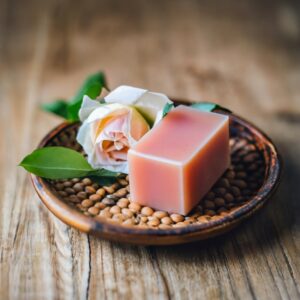
Unleash your creativity with an easy-to-follow guide on making exquisite rose melt and pour soap. This natural rose soap recipe incorporates essential oils, rosehip seed oil, and a touch of color using rose clay or pink mica.
Why Rose Soap?
Over the years, rose-inspired beauty products have gained popularity. From face toners and bath salts to body lotions and body butter, the enchanting aroma and potential skincare benefits of roses have captured our attention. Now, let’s dive into the world of DIY Rose soap.
rose soap benefits
If you have a penchant for the enchanting scent of roses, this beginner-friendly rose soap recipe is tailor-made for you. Crafted with natural ingredients, this soap not only pleases the senses but also introduces a touch of magic with an icy sugar ring frosting, a trick that elevates your soap-making game effortlessly.
What Makes This Natural Soap Special?
Prepare to fall in love with this natural soap recipe. It goes beyond a delightful fragrance; it’s a sensory experience that combines the goodness of natural ingredients with a hint of magic in the form of an easy-to-achieve icy sugar ring frosting.
Key Ingredients:
- Melt and pour soap base
- Rosehip seed oil
- Rose kaolin (for a natural pink color)
Achieving the Magical Sugar Ring: A Pro Tip for Beginners
Frosting the soap with an icy sugar ring might sound intricate, but fear not, even beginners can master this technique with ease. The result is not only visually stunning but also surprisingly simple to achieve. Impress yourself and others with the magical touch of an icy sugar ring.
Skin Benefits of Rosehip Seed Oil:
The inclusion of rosehip seed oil adds more than just a delightful fragrance to your soap. Renowned for its fantastic skin-regenerating and healing properties, rosehip seed oil contributes to the overall skincare benefits of your homemade creation.
Customizing Your Rose Soap:
- Play with Color: Rose kaolin provides a natural pink hue, but you have the flexibility to adjust the color. Use less for a paler shade of pink or omit it for a creamy white bar.
Expand Your Skincare DIY Journey:
If you find joy in creating homemade skincare products, this rose soap is just the beginning. Explore more delightful creations with my rose body butter, rose sugar scrub, or rose bath salts. Elevate your skincare routine with these handcrafted, natural wonders.
In the realm of skincare, rose takes center stage as a cherished ingredient, offering a plethora of benefits to enhance your skin’s radiance. Regarded as the queen of essential oils, rose essential oil brings forth a wealth of advantages, making it a symbol of purity, love, and longevity.
The Majesty of Rose Essential Oil:
- Purity and Symbolism: The rose flower symbolizes purity, love, and longevity, creating a botanical legacy that transcends mere skincare benefits.
Transformative Benefits of Rose Soap:
- Glowing and Fresh Skin: Incorporating rose essential oil into your beauty routine can impart a glowing and fresh look to your skin. Dilute it adequately for topical use to address issues like redness and puffiness.
- Restorative Power: Embrace the rejuvenating properties of rose oil, renowned for its ability to restore, heal, and protect the epidermis. Experience an improvement in skin texture and a reduction in fine lines, unveiling a youthful and revitalized appearance.
Tailored Skincare for All Skin Types:
- Dry, Sensitive, or Dull Skin: Rose oil emerges as a versatile solution, particularly beneficial for those with dry, sensitive, or dull skin. Its usage can lead to an improvement in overall skin condition, offering hydration and radiance.
Add Rose Soap into Your Beautifying Ritual:
Elevate your skincare routine with the natural wonders of rose soap. Let the enchanting fragrance and transformative benefits of rose essential oil become an integral part of your daily ritual. Unveil the beauty that lies within, and let your skin flourish with the regal touch of rose.
Tools for Crafting Your Homemade Rose Soap

Prepare to embark on your journey of crafting exquisite rose soap at home. In addition to gathering your quality ingredients, ensure you have the following tools ready to make the process seamless and enjoyable:
- Silicone Soap Molds:
- Variety Matters: Opt for silicone soap molds, selecting different shapes and sizes for versatility. A small rectangular mold is perfect for rose soap bars, while a tiny circular mold adds charm to hand soaps. These molds make your rose soap ideal for gifts, bridal shower favors, or special occasions.
- Heat-Proof Glass Measuring Cup with Spout:
- Precision Pouring: Invest in a heat-proof glass measuring cup with a spout, such as Pyrex. This tool facilitates effortless pouring, ensuring a smooth and controlled flow of the soap mixture.
- Mixing Utensils:
- Choose Wisely: Select wooden spoons, whisks, or silicone spatulas for mixing your rose soap ingredients. These utensils provide the right balance of flexibility and sturdiness to achieve an even blend.
- Soap Knife or Sharp Kitchen Knife:
- Precision Cutting: Have a dedicated soap knife or a sharp kitchen knife on hand for cutting the soap base into desired shapes. This ensures clean and accurate cuts, enhancing the visual appeal of your rose soap.
- Spray Bottle with Alcohol or Rubbing Alcohol:
- Bubbling Solutions: Prepare a spray bottle filled with alcohol or rubbing alcohol. This serves the purpose of popping tiny bubbles that may form on the soap’s surface after pouring, maintaining a flawless finish.
- Small Bowl:
- Colorant Preparation: Use a small bowl for mixing your soap colorant. Combine rose clay or mica with alcohol and corn starch in this bowl to achieve the desired hue for your rose soap.
how to make rose soap

Ingredients:
- 1 lb / 450 g melt-and-pour soap base (e.g. goat’s milk or shea butter)
- 1 tsp / 5 g / 0.17 oz rosehip oil
- 2 tsp pink mica
- 25 drops of rose essential oil
- High-proof alcohol (optional)
- 1/4 cup / 50 g / 1.7 oz granulated sugar (or erythritol for humid environments)
Instructions:
- Prepare Workspace:
- Wash all supplies and sanitize the workspace with soap and water or alcohol spritzes.
- Chop Soap Base:
- Cut the soap base into small cubes to facilitate the melting process.
- Melt Soap:
- Place the soap cubes in a microwave-safe container or glass measuring cup. Melt in 30-second intervals, stirring between bursts to avoid burning.
- Add Oil and Color:
- Introduce rosehip oil and essential oils into the melted soap. Mix thoroughly. Slowly add the rose clay or pink mica mixture while stirring gently.
- Pour Soap Bars:
- Spray the soap mold with alcohol to enhance adherence. Pour the liquid soap into the mold. Spritz with alcohol to dissolve bubbles.
- Solidify:
- Allow the soap to set for approximately 1 hour at room temperature or 30 minutes in the fridge.
- Unmold:
- Once solidified, gently pull back the mold to break the airlock, releasing each soap piece.
- Frost:
- Remove soap bars from the mold. Moisten the edges with water. Roll the moistened edges in sugar to coat. Let dry for a few minutes.
- Package and Store:
- Wrap soap bars tightly in plastic wrap to protect from moisture. Enjoy your delightful frosted rose soap!
Indulge in the aromatic luxury of this homemade rose soap, combining the beauty of natural ingredients with creative craftsmanship. This exquisite soap is not only a treat for the senses but also a thoughtful and personalized gift for loved ones.
How to prevent glycerin dew in rose soap

Preventing glycerin dew in rose soap, or any melt-and-pour soap, involves careful handling and storage. Glycerin dew occurs when the glycerin in the soap attracts moisture from the air, leading to the formation of tiny water droplets on the soap’s surface. Here’s how you can prevent glycerin dew in your rose soap:
- Thorough Drying:
- After crafting your rose soap, allow it to dry thoroughly before wrapping or packaging. Place the soap bars in a cool, dry area with good air circulation. This drying period helps reduce the chances of glycerin dew.
- Avoid Humidity:
- Store your rose soap in a location with low humidity. Humid environments contribute to the absorption of moisture by the soap. Consider using dehumidifiers in storage areas to maintain optimal conditions.
- Wrap Carefully:
- When wrapping your rose soap, use materials that minimize exposure to air and moisture. Consider using airtight packaging options such as vacuum-sealed bags or shrink wrap. Ensure that the soap is completely dry before wrapping.
- Avoid Sudden Temperature Changes:
- Rapid temperature changes can contribute to condensation on the soap’s surface. Store your rose soap in a consistent environment with a stable temperature to prevent fluctuations that might lead to dew formation.
- Use a Dehumidifier:
- If you live in a particularly humid climate, consider using a dehumidifier in the storage area. This appliance helps reduce excess moisture in the air, lowering the risk of glycerin dew on the soap.
- Store in Cool, Dark Place:
- Choose a storage location away from direct sunlight, as exposure to sunlight and heat can accelerate the sweating process. A cool, dark place is ideal for maintaining the soap’s quality.
- Optimal Curing Time:
- Allow your rose soap to cure for an appropriate period after crafting. While melt-and-pour soaps don’t require extensive curing like traditional soaps, a short curing time can enhance the soap’s stability.
customizing ideas for rose soap:
| Customization | Ideas |
|---|---|
| Color | Experiment with different shades of pink by adjusting the amount of rose clay or pink mica. Create ombre effects or swirls for a visually appealing look. |
| Fragrance | Besides rose essential oil, consider blending scents like lavender, geranium, or jasmine for a unique aromatic profile. |
| Additives | Integrate skin-loving additives such as dried rose petals, lavender buds, or chamomile for texture and visual appeal. |
| Shape | Use various silicone soap molds to create distinct shapes – roses, hearts, or elegant rectangles. |
| Exfoliation | Include exfoliating agents like poppy seeds or ground oats for a gentle scrubbing effect. |
| Layering | Experiment with layered designs by pouring different colored soap layers successively. |
| Embeds | Embed small decorative items like mini rose-shaped soaps or tiny hearts within the larger soap bars. |
| Texture | Achieve texture variations by incorporating ingredients like finely ground almonds or shredded coconut. |
| Packaging | Personalize packaging with custom labels, ribbons, or eco-friendly wraps to enhance the overall presentation. |
| Moisturizing Oils | Explore using other nourishing oils like argan, jojoba, or sweet almond oil for added skincare benefits. |
